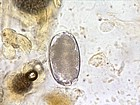Difference between revisions of "Category:Strongyloidea"
Jump to navigation
Jump to search
| Line 12: | Line 12: | ||
== General Appearance == | == General Appearance == | ||
[[Image:Strongylus.jpg|thumb|right|150px|''Strongylus'' - Joaquim Castellà Veterinary Parasitology Universitat Autònoma de Barcelona]] | [[Image:Strongylus.jpg|thumb|right|150px|''Strongylus'' - Joaquim Castellà Veterinary Parasitology Universitat Autònoma de Barcelona]] | ||
| − | Strongyloid nematodes share a a number of morphological features. They are bursate, meaning that the males have a copulatory bursa. | + | Strongyloid nematodes share a a number of morphological features. They are bursate, meaning that the males have a copulatory bursa. They are realtively short, typically 1 - 5mm, but stout in appearance with a large buccal capsule at the anterior end. The head or anterior also usually carries characteristic features such as teeth or cutting plates. |
| − | |||
| − | |||
| − | |||
| − | |||
== General Life-Cycle == | == General Life-Cycle == | ||
Revision as of 09:35, 28 July 2010
Strongyloidea
General Appearance
Strongyloid nematodes share a a number of morphological features. They are bursate, meaning that the males have a copulatory bursa. They are realtively short, typically 1 - 5mm, but stout in appearance with a large buccal capsule at the anterior end. The head or anterior also usually carries characteristic features such as teeth or cutting plates.
General Life-Cycle
- Like that of the trichostrongyloids (eggs are also 'typical strongyle eggs'), but:
- L3 → L4 → adult (typically occurs in the large intestine)
- Larvae penetrate the mucosal wall and elicit nodule formation
- Larvae of some species migrate around the body
- Prepatent period varies between species from 3 weeks to over 6 months
Peritonitis in sheep by penetration of intestines by larvae of Oesophagostomum columbianum
Strongylus edentatus and Strongylus equinus migrate through Peritoneal Cavity - Parasitic Pathology
Stephanuris dentatus causes peritonitis in pigs Peritoneal Cavity - Parasitic Pathology and may cause cysts in the pancreas
Pages in category "Strongyloidea"
The following 6 pages are in this category, out of 6 total.
